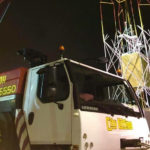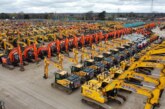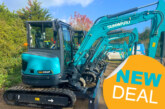In one of the most complex series of lifts in recent memory, rental firm City Lifting utilised a number of cranes and a variety of below-the-hook equipment to mobilise and erect a state-of-the-art digital air-traffic control tower at London City Airport.
In the final stages of the project, a 450t capacity Liebherr LTM1450-8.1 mobile crane lifted four 15.5t (gross load 17.7t) sections into place, each measuring 6m sq. and 9m in height. They are part of a steel tower structure that stands over 50m tall at the Thameside airfield. Integral to the lifts were a Modulift CMOD spreader frame with 4.5m x 4.5m centres and four lower MOD spreader beams at 2.2m in length to facilitate an eight-point lift.
Such frames are recommended for loads that have more than two lifting points. Struts from the MOD 24 beams were combined with four corner units to complete the frame. Customers that already have Modulift struts can re-use them with the corner units to achieve four-point lifts. However, in this case, four additional MOD 12s were used beneath at 2.2m to create the extra lifting points.
Endless web slings were utilised at various points throughout the rig; four 10t slings were used at 6m directly beneath the crane hook, while eight 5t, 2m-long slings were attached beneath the lifting frame, and the same number of 5t, 3m-long slings dropped vertically from the MOD 12s. Further, eight 6.5t bow shackles were used to connect lifting gear to eight 3t, 1m-long endless slings, double-wrapped around node connection points.
Simon Courtney, contract lift manager at City Lifting, said: “Connecting the rig to the load was the most challenging part of the job. We could only gain access to the lifting points via bosun’s chair [a device used to suspend a person to perform work aloft], which required a great deal of planning throughout the project as lifts were conducted over water and at height. The CMOD frame was originally connected directly to the crane hook but based on 11th-hour consultation with a steel designer, we were required to complicate the rig even further to support the centre spine of the tower.”
Courtney explained that, as a result, a 10t capacity chain block was connected to the hook via a 5t endless sling, while a four-leg, 6.7t capacity chain sling at 6m was rigged beneath. The legs were shortened via reduction clutches, however, and connected to four 3t, 1m-long endless slings, also double-wrapped, this time around the centre leg on a tower section’s core.
City Lifting’s scope of work actually started long before the final assembly. Buckingham Group Contracting, working for NATS Holdings (formerly National Air Traffic Services), tasked Courtney and his team with building the tower sections, using a 70t capacity mobile crane, placing them onto a barge, using a 350t capacity Liebherr LTM1350-6.1, and completing installation onsite, with the aforementioned, larger Liebherr mobile crane.
Courtney said: “It was a truly complex project from start to finish. The 450t crane had a 300t Grove sat next to it, using an 80m boom that was able to reach over the top for the larger crane with the bosun’s chair, if required, say, if a MEWP [mobile elevating work platform] broke down. The 350t crane had a 220t Demag conducting bosun’s chair activity, reaching to a maximum radius of 40m over the water.”
John Baker, sales director at Modulift, said: “The project is another great example of the Modulift CMOD system in action; it’s easy to see why this top-selling product is now the ‘go to’ option for these kind of lifts. Its adaptability, light weight design, and worldwide availability make it perfect for crane rental companies and end users alike.”









